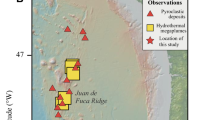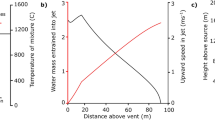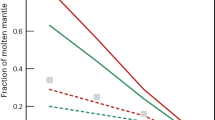Abstract
The majority of Earth’s volcanic eruptions occur beneath the sea, but the limited number of direct observations and samples limits our understanding of these unseen events. Subaerial eruptions lend some insight, but direct extrapolation from the subaerial to the deep sea is precluded by the great differences in pressure, thermal conditions, density and rheology, and the interplay among them. Here we present laboratory fragmentation experiments that mimic deep-sea explosive eruptions and compare our laboratory observations with those from the kilometre-deep submarine eruption of Havre Volcano, Kermadec Arc, New Zealand, in 2012. We find that the Havre eruption involved explosive fragmentation of magma by a pressure-insensitive interaction between cool water and hot magma, termed an induced fuel–coolant interaction. The laboratory experiments show that this water–magma interaction is initiated by the formation of cracks in cooling magma into which the water coolant can infiltrate, driving explosive fragmentation. Explosive submarine eruptions have previously been considered unlikely because stabilization of a vapour film at the magma–water contact was thought to be a key requirement but is suppressed at depths exceeding 100 m. However, here we demonstrate that these induced fuel–coolant interactions between magma and water can occur in a range of wet environments regardless of pressure, from the subaerial to the deep sea, and may operate on different planets, as well as apply to materials other than magma and water.
This is a preview of subscription content, access via your institution
Access options
Access Nature and 54 other Nature Portfolio journals
Get Nature+, our best-value online-access subscription
$29.99 / 30 days
cancel any time
Subscribe to this journal
Receive 12 print issues and online access
$259.00 per year
only $21.58 per issue
Buy this article
- Purchase on Springer Link
- Instant access to full article PDF
Prices may be subject to local taxes which are calculated during checkout





Similar content being viewed by others
Data availability
Raw data and results of t-tests, including P values, t values and degrees of freedom, are available on the open-access data archive PANGAEA42 and can be retrieved under https://doi.org/10.1594/PANGAEA.908865. Additional experimental data, including videos, are available from the corresponding author on request. Source data are provided with this paper.
Code availability
MATLAB routines used for data processing and modelling are available from the corresponding author on request. Source data are provided with this paper.
References
Carey, R. et al. The largest deep-ocean silicic volcanic eruption of the past century. Sci. Adv. 4, e1701121 (2018).
Jutzeler, M. et al. On the fate of pumice rafts formed during the 2012 Havre submarine eruption. Nat. Commun. 5, 3660 (2014).
Manga, M. et al. The pumice raft-forming 2012 Havre submarine eruption was effusive. Earth Planet. Sci. Lett. 489, 49–58 (2018).
Murch, A. P., White, J. D. L. & Carey, R. J. Characteristics and deposit stratigraphy of submarine-erupted silicic ash, Havre Volcano, Kermadec Arc, New Zealand. Front. Earth Sci. 7, 1 (2019).
Zimanowski, B., Wohletz, K., Dellino, P. & Büttner, R. The volcanic ash problem. J. Volcanol. Geotherm. Res. 122, 1–5 (2003).
Németh, K. & Kósik, S. Review of explosive hydrovolcanism. Geosciences 10, 44 (2020).
Cas, R. A. F. & Simmons, J. M. Why deep-water eruptions are so different from subaerial eruptions. Front. Earth Sci. 6, 198 (2018).
Zimanowski, B. & Büttner, R. in Geophysical Monograph Series (eds White, J. D. L. et al.) 51–60 (American Geophysical Union, 2003).
Wohletz, K. H. in Explosive Subaqueous Volcanism (eds White, J. D. L. et al.) 25–49 (American Geophysical Union, 2003).
McBirney, A. R. Factors governing the nature of submarine volcanism. Bull. Volcanol. 26, 455–469 (1963).
Board, S. J., Hall, R. W. & Hall, R. S. Detonation of fuel coolant explosions. Nature 254, 319–321 (1975).
Kokelaar, P. Magma–water interactions in subaqueous and emergent basaltic. Bull. Volcanol. 48, 275–289 (1986).
Wohletz, K. H. Explosive magma–water interactions: thermodynamics, explosion mechanisms, and field studies. Bull. Volcanol. 48, 245–264 (1986).
Zimanowski, B., Büttner, R., Lorenz, V. & Häfele, H.-G. Fragmentation of basaltic melt in the course of explosive volcanism. J. Geophys. Res. Solid Earth 102, 803–814 (1997).
Berthoud, G. Vapor explosions. Annu. Rev. Fluid Mech. 32, 573–611 (2000).
Wohletz, K. H., Zimanowski, B. & Büttner, R. in Modeling Volcanic Processes: The Physics and Mathematics of Volcanism (eds Fagents, S. A. et al.) 230–257 (Cambridge University Press, 2013).
White, J. D. L., Schipper, C. I. & Kano, K. in The Encyclopedia of Volcanoes 2nd edn (ed. Sigurdsson, H.) 553–569 (Academic Press, 2015).
Moitra, P., Sonder, I. & Valentine, G. A. Effects of size and temperature-dependent thermal conductivity on the cooling of pyroclasts in air. Geochem. Geophys. Geosyst. 19, 3623–3636 (2018).
Büttner, R., Dellino, P., La Volpe, L., Lorenz, V. & Zimanowski, B. Thermohydraulic explosions in phreatomagmatic eruptions as evidenced by the comparison between pyroclasts and products from molten fuel coolant interaction experiments. J. Geophys. Res. Solid Earth 107, 2277 (2002).
Schipper, C. I. & White, J. D. L. Magma–slurry interaction in Surtseyan eruptions. Geology 44, 195–198 (2016).
Büttner, R. & Zimanowski, B. Physics of thermohydraulic explosions. Phys. Rev. E 57, 5726–5729 (1998).
Zimanowski, B., Büttner, R., Dellino, P., White, J. D. L. & Wohletz, K. H. in The Encyclopedia of Volcanoes (eds Sigurdsson, H. et al.) 473–484 (Elsevier, 2015).
Austin-Erickson, A., Büttner, R., Dellino, P., Ort, M. H. & Zimanowski, B. Phreatomagmatic explosions of rhyolitic magma: experimental and field evidence. J. Geophys. Res. 113, B11201 (2008).
Zimanowski, B., Fröhlich, G. & Lorenz, V. Quantitative experiments on phreatomagmatic explosions. J. Volcanol. Geotherm. Res. 48, 341–358 (1991).
Schipper, C. I. et al. Vapour dynamics during magma–water interaction experiments: hydromagmatic origins of submarine volcaniclastic particles (limu o Pele). Geophys. J. Int. 192, 1109–1115 (2013).
Büttner, R., Dellino, P., Raue, H., Sonder, I. & Zimanowski, B. Stress-induced brittle fragmentation of magmatic melts: theory and experiments. J. Geophys. Res. Solid Earth 111, B08204 (2006).
Ma, Y., Zhang, Y., Huang, Y., Zhang, Y. & Hu, Z. Experimental study on flow and heat transfer characteristics of water flowing through a rock fracture induced by hydraulic fracturing for an enhanced geothermal system. Appl. Therm. Eng. 154, 433–441 (2019).
Bradshaw, A. & Schleicher, K. E. Direct measurement of thermal expansion of sea water under pressure. Deep Sea Res. Oceanogr. Abstr. 17, 691–706 (1970).
Dürig, T. et al. A new method for the determination of the specific kinetic energy (SKE) released to pyroclastic particles at magmatic fragmentation: theory and first experimental results. Bull. Volcanol. 74, 895–902 (2012).
Dürig, T., Sonder, I., Zimanowski, B., Beyrichen, H. & Büttner, R. Generation of volcanic ash by basaltic volcanism. J. Geophys. Res. Solid Earth 117, B01204 (2012).
Dürig, T. & Zimanowski, B. “Breaking news” on the formation of volcanic ash: fracture dynamics in silicate glass. Earth Planet. Sci. Lett. 335, 1–8 (2012).
Dürig, T. et al. PARTIcle Shape ANalyzer PARTISAN – an open source tool for multi-standard two-dimensional particle morphometry analysis. Ann. Geophys. 61, VO671 (2018).
Dellino, P. & La Volpe, L. Image processing analysis in reconstructing fragmentation and transportation mechanisms of pyroclastic deposits. The case of Monte Pilato-Rocche Rosse eruptions, Lipari (Aeolian Islands, Italy). J. Volcanol. Geotherm. Res. 71, 13–29 (1996).
Cioni, R. et al. Insights into the dynamics and evolution of the 2010 Eyjafjallajökull summit eruption (Iceland) provided by volcanic ash textures. Earth Planet. Sci. Lett. 394, 111–123 (2014).
Leibrandt, S. & Le Pennec, J.-L. Towards fast and routine analyses of volcanic ash morphometry for eruption surveillance applications. J. Volcanol. Geotherm. Res. 297, 11–27 (2015).
Liu, E. J., Cashman, K. V. & Rust, A. C. Optimising shape analysis to quantify volcanic ash morphology. GeoResJ 8, 14–30 (2015).
Schmith, J., Höskuldsson, Á. & Holm, P. M. Grain shape of basaltic ash populations: implications for fragmentation. Bull. Volcanol. 79, 1–16 (2017).
Dürig, T., Mele, D., Dellino, P. & Zimanowski, B. Comparative analyses of glass fragments from brittle fracture experiments and volcanic ash particles. Bull. Volcanol. 74, 691–704 (2012).
Brosius, F. SPSS 8 Professionelle Statistik unter Windows (mitp-Verlag, 1998).
Welch, B. L. The generalization of ‘Student’s’ problem when several different population variances are involved. Biometrika 34, 28–35 (1947).
Perneger, T. V. What’s wrong with Bonferroni adjustments. BMJ 316, 1236–1238 (1998).
Dürig, T. et al. Fragmentation experiments with Havre melt: dry and induced fuel-coolant interaction runs. PANGAEA https://doi.org/10.1594/PANGAEA.908865 (2019).
Holmgren, M. X Steam, Thermodynamic properties of water and steam. MATLAB Central File Exchange. https://go.nature.com/3hxTRbh (accessed 21 April 2020).
Acknowledgements
L. Schmid, R. J. M. Baxter and D. Longridge are acknowledged for assisting with particle analysis. We thank I. Schipper for proof-reading and gratefully acknowledge I. Sonder for helpful comments that substantially improved an earlier version of the manuscript. This study was supported by MARSDEN grant U001616; Havre samples were obtained with NSF funding EAR1447559. R.J.C. was funded by Australian Research Council grants DP110102196 and DE150101190, and by US National Science Foundation grant OCE1357443.
Author information
Authors and Affiliations
Contributions
J.D.L.W. designed and supervised the Marsden research project. T.D., J.D.L.W., B.Z., R.B. and A.P.M. conducted the laboratory experiments at Physikalisch Vulkanologisches Labor, University of Würzburg. T.D. and N.S. sampled the experimental particles. T.D. conducted two-dimensional morphometry and statistical analysis of both experimental and natural ash with support from D.M. and P.D. D.M., P.D. and T.D. conducted X-ray microtomography and image reconstruction. L.S.S. computed thermal expansion coefficients. R.J.C. was leader of the NSF cruise and helped formulate the Marsden project. J.D.L.W., R.J.C. and A.P.M. took part in the NSF cruise and collected the dome rock used as starting material for melt fragmentation experiments. R.J.C. and A.P.M. provided Havre ash samples and related metadata, including the bathymetric map. Figures and plots were produced by T.D. and L.S.S. T.D. and J.D.L.W. wrote the manuscript, with contributions from all the authors.
Corresponding author
Ethics declarations
Competing interests
The authors declare no competing interests.
Additional information
Peer review information Primary Handling Editor: Rebecca Neely.
Publisher’s note Springer Nature remains neutral with regard to jurisdictional claims in published maps and institutional affiliations.
Extended data
Extended Data Fig. 1 Notation of studied ash samples and sample locations.
a, labels of the ten different particle samples analysed for this study. b, photo showing droplets deposited after open IFCI experiments at the ceilings and walls around the experimental area. These droplets contain very fine particles, which are denoted “IW” samples. c, map showing vicinity of Havre volcano. It was acquired in 2015 and is adapted from Carey et al.4. Indicated changes can be attributed to the 2012 eruption. Next to pumice and ash, this eruption featured also eleven lava flows, here denoted “A” through “N”. The rocks used for the melt experiments presented in this study were collected at the newly formed dome labelled “OP”.
Extended Data Fig. 2 Recoil-force and driving pressure recorded in fragmentation runs.
a, Maximum recoil force Fmax and pressure Pmax measured for dry (“D”, red) and IFCI runs (blue). Squares indicate experiments with reduced (100 g) melt mass mmelt. Fmax represents “explosiveness” of response to the initiating driving pressure. Pressure and force curves given for the three strongest dry (b-d) and IFCI (e-g) runs. Measurement uncertainties are within marker sizes.
Extended Data Fig. 3 Grainsize distribution of experimental particles.
a, grainsize distributions for seven dry runs and b, for five IFCI runs. Black curves for cumulative sums averaged over all samples demonstrate increased amounts of ash generated by IFCI. Notation as in Extended Data Fig. 2.
Extended Data Fig. 4 Thermal expansion coefficient for different pressures.
Compared to surface pressure conditions (0.1 MPa), the boiling temperature of water at 1 km depth is significantly higher. This allows the water to reach regimes with considerably higher thermal expansion coefficients. This is one of the reasons why IFCI processes are enhanced under deep-sea conditions.
Extended Data Fig. 5 Schematic setup for dry and IFCI runs.
a, cross-section illustrates the configuration of gas inlet and location of sensors. b, gas reservoir used to provide the pressurized argon gas for fragmentation experiments.
Extended Data Fig. 6 Shape parameters and maximum distance ranges Dmax used for morphometric analyses.
The mathematical definitions of the shape parameters can be found in the listed sources. All parameters were computed using the software PARTISAN. Note that some of the shape parameters are used through the various systems, though not always identically named32.
Extended Data Fig. 7 Statistical testing procedure followed for comparative morphometric analysis.
Two samples were first tested for significant differences in their 23 shape parameters, using one of the two t-tests. If variances were comparable, and no significant difference was found in any of the shape parameters, calibrated e-tests were applied to check for significant similarity.
Extended Data Fig. 8 Results of equivalence tests between sample IU (grains retrieved via U-tube in IFCI runs) and natural ash grains (Nat1–Nat6).
Values represent the calculated minimum range D, under which the equivalence test would still be passed. The maximum value of D for each shape parameter is presented in the column labelled “max. diff.”. If this value is equal or smaller than the threshold for curvi-planar ash grains (Dmax, see also Extended Data Fig. 6), the compared data sets can be treated as significantly similar in the according shape parameter. Equivalence test results are only valid for data sets with homogeneous variances. If this precondition is not fulfilled, results were omitted, denoted by “(...)”. None of these values exceed the threshold given by Dmax, hence it can be concluded that experimental IFCI particles retrieved via U-tube and natural grains show no detectable difference in their shapes.
Extended Data Fig. 9 Results of equivalence tests between sample IW (grains retrieved after IFCI runs inside water droplets, deposited at ceilings and walls) and natural ash grains (Nat1–Nat6).
Values represent the calculated minimum range D, under which the equivalence test would still be passed. The maximum value of D for each shape parameter is presented in the column labelled “max. diff.”. If this value is equal or smaller than the threshold for curvi-planar ash grains (Dmax, see also Extended Data Fig. 6), the compared datasets can be treated as significantly similar in the according shape parameter. Equivalence test results are only valid for datasets with homogeneous variances. If this precondition is not fulfilled, results were omitted, denoted by “(...)”. None of these values exceed the threshold given by Dmax, hence it can be concluded that IW particles and natural grains show no detectable difference in their shapes.
Extended Data Fig. 10 Results of equivalence tests between sample IW and IU.
Values represent the calculated minimum range D, under which the equivalence test would still be passed. If this value is equal or smaller than the threshold for curvi-planar ash grains (Dmax, see also Extended Data Fig. 6), the compared data sets can be treated as significantly similar in the according shape parameter. Equivalence test results are only valid for data sets with homogeneous variances. If this precondition is not fulfilled, results were omitted, denoted by “(...)”. In 12 of the tested 23 shape parameters, a significant similarity is verified via e-tests. In the other 11 shape parameters, no statement can be made.
Supplementary information
Supplementary Video
Movie clips showing an IFCI run with U-tube. The recorded frame rates were 50 fps (played back at 100% and 10% speed), 30 fps (played back at 10% speed) and 3,000 fps (played at 20 fps). At 33 ms after the start of fragmentation, the U-tube separates from the crucible. The bulk of particles which were retrieved in the water bowl originate from the leading clast front, which has already passed through the pipe at this time. No researchers were harmed during the making of these films.
Source data
Source Data Fig. 3
Force, pressure and sieve analysis data.
Source Data Extended Data Fig. 2a
Force and pressure data.
Source Data Extended Data Fig. 3
Sieve analysis data.
Rights and permissions
About this article
Cite this article
Dürig, T., White, J.D.L., Murch, A.P. et al. Deep-sea eruptions boosted by induced fuel–coolant explosions. Nat. Geosci. 13, 498–503 (2020). https://doi.org/10.1038/s41561-020-0603-4
Received:
Accepted:
Published:
Issue Date:
DOI: https://doi.org/10.1038/s41561-020-0603-4
This article is cited by
-
Controls on juvenile ash morphologies in lava fountains: insights from laboratory experiments
Bulletin of Volcanology (2023)
-
Assessing volcanic hazard and exposure to lava flows at remote volcanic fields: a case study from the Bolaven Volcanic Field, Laos
Journal of Applied Volcanology (2022)
-
Seawater-magma interactions sustained the high column during the 2021 phreatomagmatic eruption of Fukutoku-Oka-no-Ba
Communications Earth & Environment (2022)
-
Havre 2012 pink pumice is evidence of a short-lived, deep-sea, magnetite nanolite-driven explosive eruption
Communications Earth & Environment (2022)
-
The effect of wind and plume height reconstruction methods on the accuracy of simple plume models — a second look at the 2010 Eyjafjallajökull eruption
Bulletin of Volcanology (2022)



